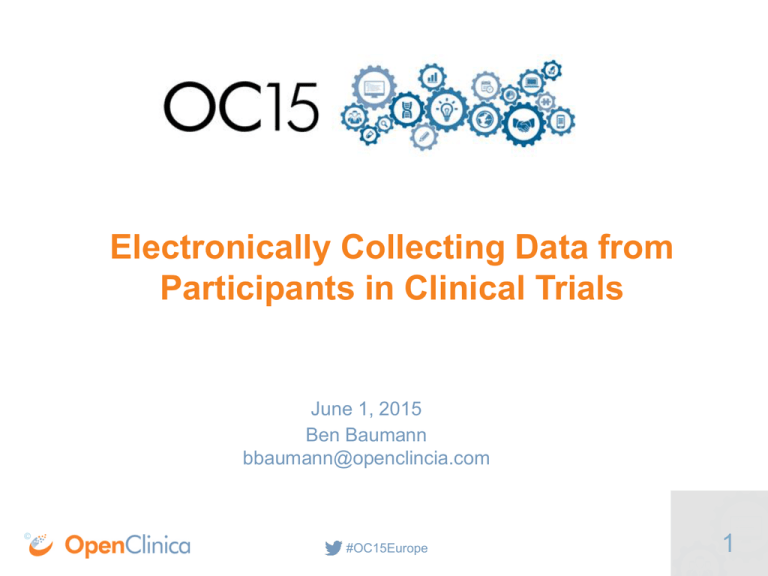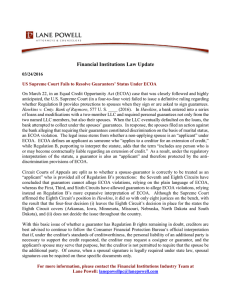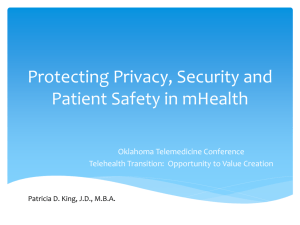Electronically Collecting Data from Participants in
advertisement

Electronically Collecting Data from Participants in Clinical Trials June 1, 2015 Ben Baumann bbaumann@openclincia.com © #OC15Europe 1 Trajectory Terminology Benefits & Promises Barriers & Reality Technology Regulatory Content Data Management © #OC15Europe 2 © #OC15Europe 3 eCOA (electronic clinical outcomes assessment) Definition: an electronic assessment that may be influenced by human choices, judgment, or motivation and may support either direct or indirect evidence of treatment benefit. Patient Driven eData Assessment = instrument = questionnaire = form… © #OC15Europe 4 eCOA Modalities Modality Definition Use When Examples ePRO Data reported electronically directly verbatim by subjects. Self report, or interview. • Trained health professional not needed + self-report feasible and appropriate. • Unobservable concepts (feelings, sensations) • Pain intensity • Mood/feelings • Eating habits Report from a health-care professional observing subject’s condition. Involves clinical judgement/interpretation. Trained health professional needed • tumor size • Parkinson’s patient who cannot comment • palpating a spleen Measurement based on an observation by someone other than the patient or a health professional. Does not include medical judgment/interpretation. Trained health professional not needed and self-report NOT feasible/appropriate. • parent/infant • caregiver/elderly person Performance of a task by subject based on instructions administered by a HC professional The specific task is required by protocol • 6 minute walk test • Memory recall (Patient-reported outcomes) ClinRO (Clinician-reported outcome) ObsRO (Observer-reported outcome) PerfO (Performance outcome) © #OC15Europe 5 Why do it? © #OC15Europe 6 Quality Productivity • Better data • Faster, less labor • Engage patients in Enablement new ways © #OC15Europe 7 May Clinic Study 3,704 cancer patients How would you describe your overall quality of life today? 0 1 2 3 4 5 6 As bad as can be 7 8 9 10 As good as can be Score of 5 or less, 15 months survival Sore of 5+, 52 months survival Cannot ignore decrease of 2 This is a prognostic factor for cancer patient survival © #OC15Europe 8 Incorporated QOL assessment into daily clinical oncology practice Initiated conversations with patients Insomnia Stupid thoughts Reduced emergent care Improved survival Improved quality of life © #OC15Europe 9 Paper vs. Electronic Paper eCOA Piles of paper can be confusing Don’t need to worry about the internet Chance of getting lost/destroyed Slow access to actionable More controlled experience System prompts user automatically Increased compliance (regulatory, information Parking lot syndrome © #OC15Europe patient) Requires secure login/password Date/Time Stamped in Audit Trail E-Source recorded in Audit Trail 10 Drivers of eCOA Quality & Efficiency Increased data quality (edit checks, data types, show/hides, required fields) More efficient data collection (reduce need for data entry) Improved patient compliance1,2 Auto-reminders Electronically monitor Cost savings Know exactly when something happens Report deviations to sites immediately Get data earlier to prevent problems Better patient care 1 ePRO often produces compliance rates over 90%. See Meltzer EO, Kelley N, Hovell MF (2008). "Randomized, Cross-Over Evaluation of Mobile Phone vs Paper Diary in Subjects with Mild to Moderate Persistent Asthma". 2 Friedberg F, Sohl SJ (2008). "Memory for Fatigue in Chronic Fatigue Syndrome: The Relation Between Weekly Recall and Momentary Ratings". International Journal of Behavioral Medicine 15 (1): 29–33 © #OC15Europe 11 Drivers of eCOA (cont.) Technology trends Ubiquity of internet access Mobile devices Responsive design Sensory devices Apple ResearchKit © #OC15Europe 12 Drivers of eCOA (cont.) Patient engagement Integrate into subjects’ lives, especially if BYOD Fewer dropouts More events Feedback Improvement over time Comparison vs. the field Increased Compliance Engaged Patients © #OC15Europe 13 eCOA in an ALCOA World Attributable Login / access code Legible It’s digital, structured Contemporaneous Can control when things happen Original ePRO captured directly from subject Accurate Edit checks, rules logic Complete Consistent Enduring Available © #OC15Europe 14 © #OC15Europe 15 Barriers to Adopting eCOA Expense (or, at least perceived expense) Devices / Logistical complexity Usability Fit with study population Integrating with existing EDC/CDM Systems “Translating” existing PROs to electronic form Others? What has stopped you? © #OC15Europe 16 Adoption of eCOA 2009 FDA PRO guidance1 More trials are collecting COA data Use of BYOD increasing, but mostly in post-approval studies Scientific evidence growing to broaden use Technology farther ahead of the regulations and adoption 1 http://www.fda.gov/downloads/Drugs/Guidances/UCM193282.pdf © #OC15Europe 17 Formula for Success Success = Planning + Implementation So, let’s break it down: • • • • Patient experience Content Regulations Technology © #OC15Europe 18 Patient Experience How will you engage your patients? Motivation Incentive Feedback © #OC15Europe 19 Usability Number of forms/instruments Items per page Scolling “Simple can be harder than complex: You have to work hard to get your Edit checks thinking clean to make it simple. But it’s worth it in the end because once you Required fields get there, you can move mountains.” Skip logic - Steve Jobs Accommodating disabilities Offline Support: patients, devices, logistics © #OC15Europe 20 Language press click mouse select choose enter Will instrument be translated? Avoid idiomatic expressions Allowing for text length Left Right, Right Left © #OC15Europe 21 Item Stems & Recall Making questions self contained During the last week, how has the pain interfered with: Going to work Sleeping at night During the last week, how has the pain interfered with going to work? During the last week, how has the pain interfered with sleeping at night? © #OC15Europe 22 Usability Testing Field-test involving patients (ePRO) and/or clinicians (ClinRO) -- use the real thing © #OC15Europe 23 Electrifying Existing COAs Must show eCOA version yields data which are equivalent or superior to paper version. eCOA version must measure the same thing as paper Need to show evidence of evidence of equivalence1 Level of evidence depends on severity of change 1 FDA PRO Guidance 2009: http://www.fda.gov/downloads/Drugs/Guidances/UCM193282.pdf © #OC15Europe 24 Evidence of Equivalence Table from ISPOR ePRO Task Force Paper: http://www.ispor.org/workpaper/patient_reported_outcomes/Coons.pdf © #OC15Europe 25 Content: Leveraging Others’ Work C-Path PRO and ePRO Consortia (www.c-path.org) Pre-competitive, FDA + industry Collaborate to generate measurement equivalence data Best practices PROMIS (www.nihpromis.org/) Freely distributes instruments Tested, multiple languages ISPOR (http://www.ispor.org/) © #OC15Europe 26 Regulations: Available Guidance © #OC15Europe 27 2009 FDA PRO Guidance How FDA reviews and evaluates existing, modified, or newly created patient-reported outcome (PRO) instruments used to support claims in approved medical product labeling. © #OC15Europe 28 © #OC15Europe 29 2013 FDA E-Source Guidance Assure reliability, quality, integrity, and traceability of data from electronic source to electronic regulatory submission. Promotes capturing source data in electronic form Retention of electronic source data in FDA-regulated clinical investigations. © #OC15Europe 30 2013 Mobile Medical Applications © #OC15Europe 31 Mobile Medical Applications Mobile App: A software application that can be run on a mobile platform, or a web-based software application that is tailored to a mobile platform but runs on a server. Mobile Medical App: A mobile app that meets the definition of a device and is intended: To be used as an accessory to a regulated medical device To transform a mobile platform into a regulated medical device (e.g., via a sensor or electrode) FDA intends to apply its regulatory oversight to only those mobile apps that are medical devices and whose functionality could pose a risk to a patient’s safety if the mobile app were to not function as intended. © #OC15Europe 32 Technology © #OC15Europe 33 Choices, choices… Choice Considerations Smart Phone • • • • Typically used for ePRO Well-integrated messaging (SMS, phone, email) Smaller screens may present issues for certain instruments Logistics if provisioning Tablets • • • • Typically used in ClinRO settings More readily emulate paper Logistics if provisioning Less validation burden Digital Pen • • • • Special pen, special paper Still have paper Legibility Technology support IVR • • • Limited types of questions Recall time Patients get frustrated Web-based © #OC15Europe 34 App vs. Web Limitations and Liberties Pushing updates Validation Data stored on device Responsive design What actually is the app? Web? App? © #OC15Europe 35 Device Provisioning vs. BYOD Device BYOD User may forget Already in habit of using Greater control Unknown device configurations Connectivity issues Already connected Simpler validation Device checks Responsive design Connectivity issues Participate already connected Lots of logistics and support Little to none Hybrid BYOD / Provisioning an option BYOD? Provide device? …or both? © #OC15Europe 36 Role of Data Management Edit checks/controls at entry Required fields: complete data vs. accurate data Frequency of data collection EDC/CDMS integration Reviewing data How to handle data received too early / too late Clear policy with sites around changing ePRO data (e.g. visit dates, basic demographics) Under control of investigator at all times Paper as back-up; how to handle Site Support, FAQ © #OC15Europe 37 Putting it All Together © #OC15Europe 38 Thinking About ROI Paper Vs. Costs you are incurring: Printing Mailing Data Entry Data Cleaning Electronic Costs you are incurring: Some estimates as high as $20 per page Electronic system Costs you are saving: Less data entry Less data cleaning Printing and mailing Fewer site payments Quality benefits: Increased accuracy Removing interpretation More time for patients Faster study closeout © #OC15Europe 39 We Can Do This! Technology has advanced and we have the power to use that technology to improve patient care. © #OC15Europe 40 Thank You! Ben Baumann OpenClinica, LLC bbaumann@openclincia.com © #OC15Europe 41







